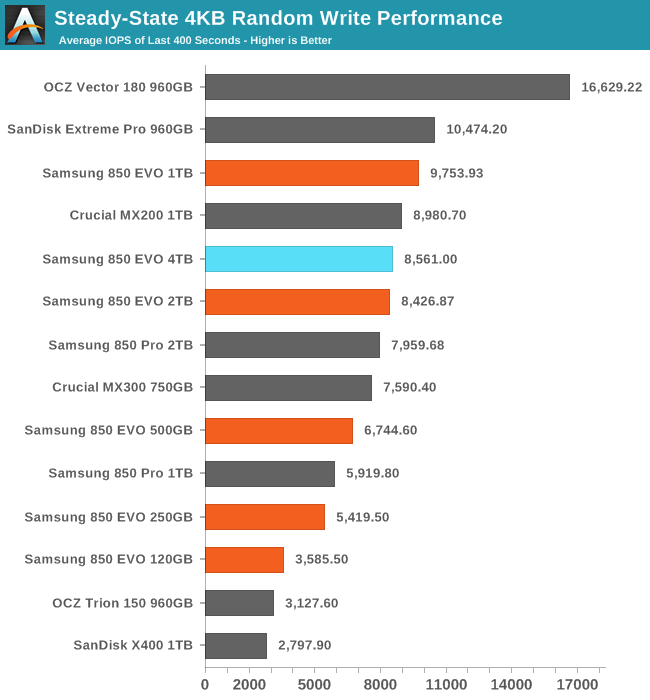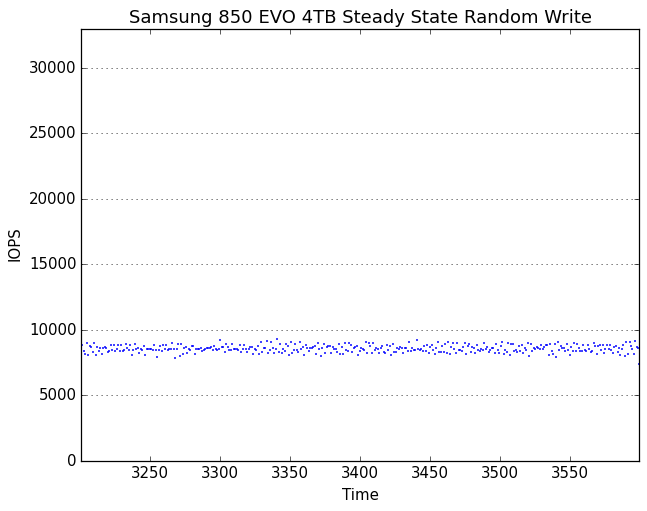The Samsung 850 EVO 4TB SSD Review
by Billy Tallis on July 11, 2016 10:00 AM ESTPerformance Consistency
Our performance consistency test explores the extent to which a drive can reliably sustain performance during a long-duration random write test. Specifications for consumer drives typically list peak performance numbers only attainable in ideal conditions. The performance in a worst-case scenario can be drastically different as over the course of a long test drives can run out of spare area, have to start performing garbage collection, and sometimes even reach power or thermal limits.
In addition to an overall decline in performance, a long test can show patterns in how performance varies on shorter timescales. Some drives will exhibit very little variance in performance from second to second, while others will show massive drops in performance during each garbage collection cycle but otherwise maintain good performance, and others show constantly wide variance. If a drive periodically slows to hard drive levels of performance, it may feel slow to use even if its overall average performance is very high.
To maximally stress the drive's controller and force it to perform garbage collection and wear leveling, this test conducts 4kB random writes with a queue depth of 32. The drive is filled before the start of the test, and the test duration is one hour. Any spare area will be exhausted early in the test and by the end of the hour even the largest drives with the most overprovisioning will have reached a steady state. We use the last 400 seconds of the test to score the drive both on steady-state average writes per second and on its performance divided by the standard deviation.

The 4TB 850 EVO restores a little bit of the performance that the 2TB lost relative to the 1TB, but Samsung's controller architecture is still clearly most comfortable at 1TB.

The consistency of the 2TB 850 EVO was only slightly better than the 1TB EVO, so it's surprising to see the 4TB model make such a large jump and come so close to the 1TB 850 Pro.
 |
|||||||||
| Default | |||||||||
| 25% Over-Provisioning | |||||||||
It is no surprise that a 4TB drive lasts so long before dropping out of peak performance: it has far more spare area to burn through than any ordinary consumer SATA SSD. The transition to steady state is uncharacteristically long and messy for a Samsung drive, and the performance lows during this period are disappointing. Once the drive has reached steady state, there's nothing to complain about.
 |
|||||||||
| Default | |||||||||
| 25% Over-Provisioning | |||||||||
There are no wild outliers from the 4TB 850 EVO's steady-state, and none of the longer-term drift in performance shown by the 1TB and 2TB 850 EVO and Pro models. With extra overprovisioning, the 4TB EVO carries on indefinitely with high and extremely steady performance.










145 Comments
View All Comments
Eden-K121D - Monday, July 11, 2016 - link
Too Expensive. $999 would have been a sweet spot and a potential option for meZak - Monday, July 11, 2016 - link
The price will come down. Eventually.Ratman6161 - Monday, July 11, 2016 - link
Doesn't really mater if the price goes down, its still a niche product. The EVO's are great general purpose desktop drives. But the people who need a general purpose desktop drive, mostly don't need 4TB and would not buy one at $500 let alone at $1500. In my case, I've got a 250GB Evo and a 1 TB spinning disk for storage of music, pictures, video etc. So I guess a cheap enough 2 TB SSD could work for me just because it would be marginally easier to not have two separate chunks of storage to deal with...but thats just a marginal increase in convienience. The stuff I have on a spinning disk doesn't really need the performance of an SSD anyway.I know, now someone will jump in with "well I sure need that 4 TB" but I still say that isn't the norm. I really don't believe they will sell very many of these compared to the 1 TB and below even if the price comes down.
Meteor2 - Monday, July 11, 2016 - link
I don't need it. But it's exciting to see this progress in SSDs. It'll take a while but mass production will bring the price/size ratio down.Impulses - Monday, July 11, 2016 - link
OTOH lack of competition will probably counter that to an extent... But I'm glad it exists too, if nothing else it might mean more sales on the 2TB. :pleexgx - Sunday, August 7, 2016 - link
was so funny when i clicked on 25% OP, but really the extra OP is really only needed for places where your writing constantly as normally the drive is Trimmed (most SSD/HDDs life is read then write, unless in a server setup that does lots of writes) the drives normal hidden OP is what 400-500MB ?beginner99 - Tuesday, July 12, 2016 - link
Agree. This shows that HDDs are here to stay for another decade. The same for 4 TB in form of a HDD can be had for about $130. So that 1/10th of the SSD price and as you said for media files, you don't need an SSD at all.Impulses - Wednesday, July 13, 2016 - link
Another decade? That seems like a stretch unless you're hoarding BD tips and the like... A decade ago we didn't even have SSDs.joex4444 - Tuesday, July 19, 2016 - link
If you have 4TB of stuff to store and it's mostly media that is accessed infrequently, it would only make sense to buy a 4TB SSD over a 4TB HDD if the prices are comparable. We've technically had SSDs for decades, it's just that they used to be in the millions of dollars per drive rather than $100 or so. Exactly how production will change to make 4TB drives cheaper isn't clear. It could be that we've already reached the lowest price per GB and all that remains is to have that scale linearly. This would mean that if 250GB drives cost $60, then a 4TB drive should cost 16 times that, or $960. Maybe some kind of discount could bring it into the $750 range, but in order to get down to $130 we need significant changes. That would put a 250GB drive on the order of $25.JimmiG - Wednesday, July 13, 2016 - link
Of course it's not "needed" right now, but it's nice to see progress. The 6 GB HDD I used in my Pentium system was plenty at the time - I didn't "need" those fancy new 20 GB drives...